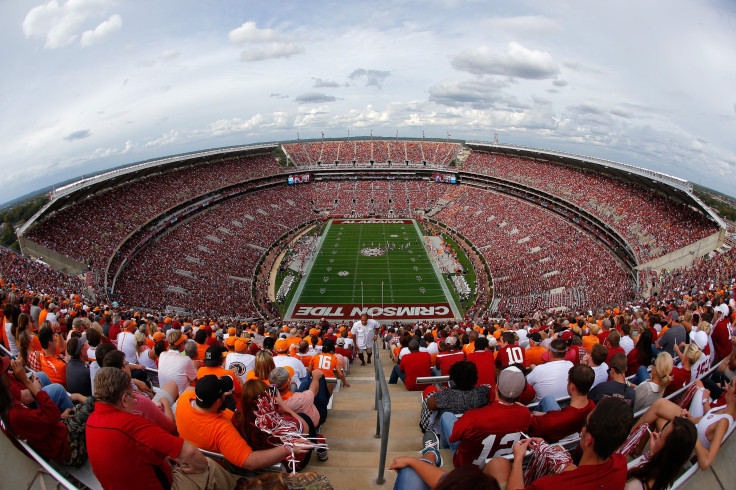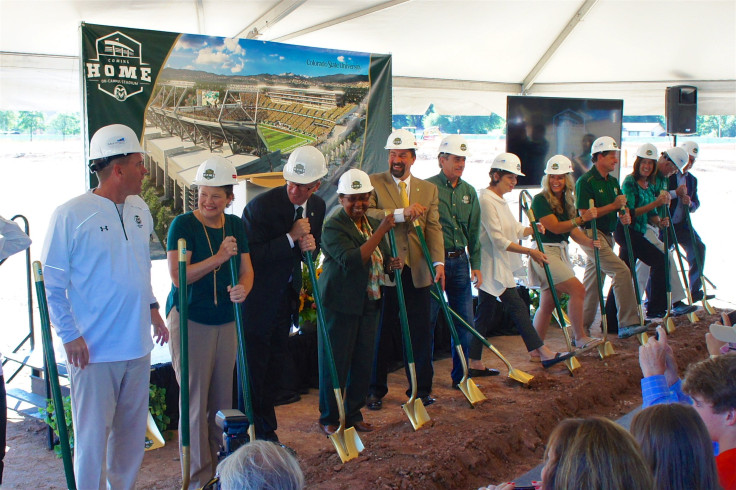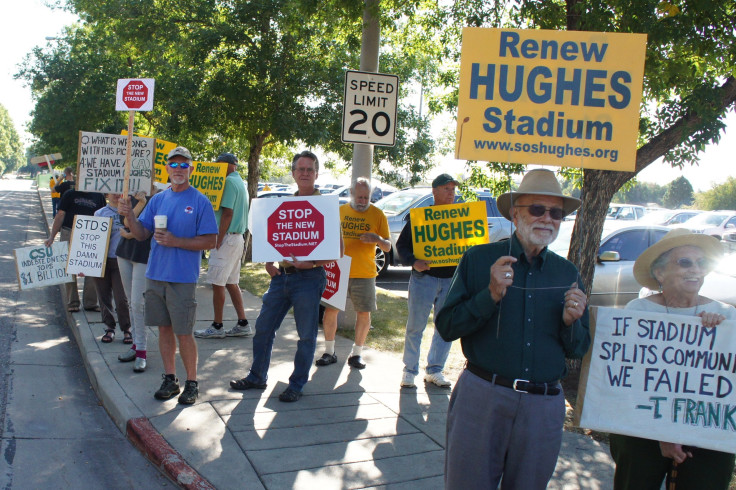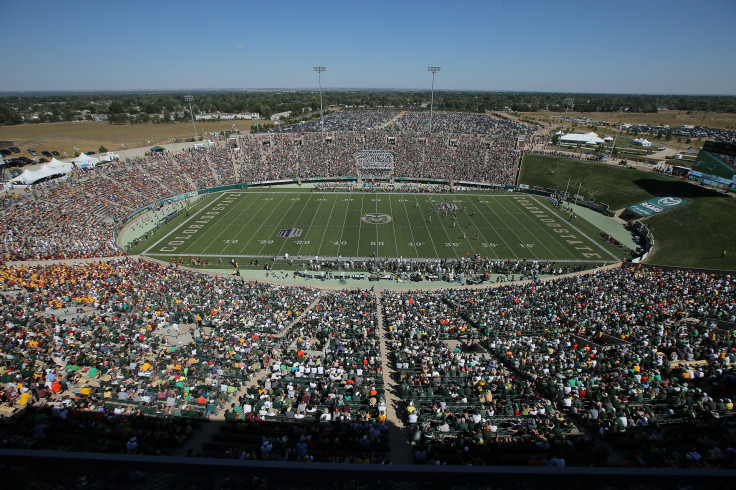College Football: Public Universities Spend Millions On Stadiums, Despite Slim Chance For Payoff

When Americans tune into Monday night’s national championship game, they will be watching two public universities whose football programs are the envy of hundreds of other schools — and not just for their on-field achievements. Clemson’s program generates a healthy revenue surplus for the South Carolina school, which is now investing in a new athletic village replete with laser tag and mini golf to attract recruits. The University of Alabama has one of the most lucrative athletic enterprises in sports, generating more money than any professional hockey team.
These apparent success stories — in two of America’s poorest states — would seem to suggest that public universities’ escalating spending on college football programs and stadiums is a shrewd investment, especially at a time when state legislatures are reducing their taxpayer support for higher education. And there are others: The football team of the University of Texas at Austin, for example — which has spent $176 million on stadium upgrades in the last decade — generates the most revenue in the nation. Texas A&M’s football program — which recently benefited from a $450 million stadium upgrade — also ranked among the top 20 schools in revenue.
But those schools are exceptions. Most public universities lose money on their athletic programs — and many have been running up ever-bigger debt to finance stadiums. The trend has occurred even though there is little evidence that football provides major revenue for expanding academic programs or reducing skyrocketing tuition. Instead, as college football has become a multibillion-dollar business demanding state-of-the-art facilities and massive coaching salaries, it is taxpayers and already debt-burdened students who ultimately pay the bill.
“There is this notion that by building the stadium you are going to go up to some higher class of college sports, and being in this higher class of college sports you are going to get more exposure, you are going to get more out-of-state applications and you are going to get more people donating to your school or to your athletics program,” said Smith College sports economist Andrew Zimbalist, in a 2013 presentation about the economics of college stadiums.
“The problem is that the empirical data — the evidence that’s out there — is not very supportive of those claims or of those hopes,” he said.
The football spending binge continues at large and small public universities alike.
Between 2009 and 2013, public universities reported increasing their annual expenditures on football to more than $1.8 billion — a 21 percent jump in inflation-adjusted dollars, according to Knight Commission data reviewed by International Business Times. In that same time period, public universities’ reported debt on their athletic facilities has grown to $7.7 billion — up 44 percent in inflation-adjusted dollars in that time. In all, two thirds of Division I public universities increased their spending on football or athletic facilities in that time period — when average tuition and student fees at public universities have risen more than 40 percent in the last decade.
The payoff for all that investment? Nearly three quarters of all Division I football programs now run deficits, which are eventually covered by the rising tuition and student fees.
Cautionary tales abound: The University of California-Berkeley, for instance, had been reducing its athletic subsidies, but then incurred $445 million of debt to renovate its football stadium and build a new student athletic center. That decision was followed by weaker-than-expected attendance and ticket sales, which has complicated the school's plan for paying off the bonds it issued to finance the projects.
The University of Akron, which completed construction of a $62 million stadium in 2009, is in a similar bind. The facility seats 30,000 but average attendance at games in 2014 was below 10,000 — the lowest in major Division I college football, according to the NCAA. As of 2013, the school faced more than $73 million in debts for its athletic facilities. That is part of the more than half-billion in debts which, school officials told local media, has led to layoffs and to higher fees for students.
In Philadelphia, education leaders seem torn. Drexel University President John Fry last week published a Wall Street Journal op-ed urging higher education officials to rethink their commitment to football, saying his own school’s lack of a program is a “major strategic advantage.” On the other side of town, though, state-supported Temple University is planning a $100 million football stadium.
Temple is one of many public institutions pouring more money into football even though its program has not generally been considered a name-brand powerhouse. According to Knight Commission data, the schools increasing their football spending the fastest include Sam Houston State University, South Dakota State University, Savannah State University and Southern University and A&M College. Meanwhile, Lamar University, James Madison University and Northern Arizona University spent big on football stadiums. Now, each of those schools’ athletic departments relies primarily on student fees and university general funds — as opposed to self-generated ticket sales and TV revenue — to finance their budgets.
Colorado’s New Stadium
Still, for schools increasingly worried about funding, a kind of Fantasy Football — the hope that an upgraded program will produce an invitation to join a conference with a rich TV deal — retains its allure. On a sunny Sunday morning last fall, a crowd dressed in green and gold gathered on a brown field on the campus of Colorado’s second-largest university. Colorado State University officials and boosters urged the audience to picture the spot in 2017, when the now-empty lot will be the home of a gleaming new $238 million football stadium.
“I’m looking forward to a larger celebration,” CSU President Frank told the throng, “when we’re here for a ribbon-cutting to celebrate coming home to the Colorado State University campus.”

Situated in Ft. Collins about an hour’s drive north of Denver, CSU is emblematic of many other public universities betting big on football: It is a 32,000-student land grant school focused on technical education in a state whose legislature provides some of the lowest per-student funding of higher education in America — and its football program is currently in a conference that does not generate huge television money.
“Part of this project is obviously about building a football program and the recruiting that comes from this, and then the success that comes from recruiting,” said Mike Hooker, the CSU spokesman. “But the whole other and more important piece of this is connecting alumni, students and the community to campus... They can bring their kids to a game and say, 'This is where I went to college,' and hopefully the kids say, oh, CSU. Hey, I might want to go to college here.”
To finance this vision, Colorado State is incurring more than $400 million in principal and interest payments, pushing its overall debt to more than $1 billion. According to inflation-adjusted data from the Knight Commission on Intercollegiate Athletics, by 2013 Division I public universities owed roughly $7.7 billion on athletic facilities.
Every year, those universities collectively must cough up more than a half billion dollars to pay down that debt — roughly double the annual debt service payments for public universities’ athletic facilities from eight years ago. And if revenues from ticket sales, merchandising and fundraising do not cover the bills — as they typically do not — students and the general public are on the hook, either through fees, higher tuition or taxpayer money.
During the ground-breaking ceremonies at CSU, the chants of those who oppose the project could be heard from behind a distant fence. University President Frank acknowledged the controversy, saying the “criticisms caused us to check everything not twice, but three or four times, to sharpen our pencils, to reflect, to be careful, and I believe they made this project better in the end.”
‘Show Me The Money’
When the stadium proposal first began moving forward, a poll of CSU students showed that the majority wanted the school simply to renovate its existing facility, Hughes Stadium.
“CSU, it’s time to start thinking about your students’ wallets instead of your image and an on-campus stadium,” wrote Darin Hinman, then the editor of the student newspaper in 2013. “We are all here to get our degree and make a hopefully successful career after college. However, at this rate it won’t be long before we will no longer be able to afford college at all.”
In interviews with International Business Times, some of the assembled protesters carrying picket signs expressed concerns about the stadium potentially increasing traffic in the heart of Ft. Collins, a tight-knit college town of 158,000. Others said there was no evidence that a new campus stadium would actually help downtown Ft. Collins — a view supported by a 2007 study by Pennsylvania State University researchers that found the overall success of a college football program did not have “a discernable impact on either employment or personal income in the cities where the teams play.” Still others pointed out that Hughes could be upgraded for far less than the cost of a new facility.
“I come out of the business world and when I look at this from a dollars and cents view, I don’t understand how this makes any sense,” said Bob Vangermeersch, a retired head of a Ft. Collins manufacturing firm who has led a local group opposing the CSU stadium. “Who themselves would invest their own money in a program that is losing millions of dollars a year? Nobody, so why would we do it at our state university?”

Vangermeersch provided IBT with a detailed audit of CSU’s books for a state legislative committee in 2014. He said the report proves that the school is already using tuition, student fees and taxpayer money to subsidize its football program — and he argued that a new stadium could require the subsidies to be even bigger.
According to the report, CSU’s athletic department — like most public universities — runs a deficit. It spent more than $38 million on operations, but generated only $18 million from ticket sales, donations, concessions and ads. The football program itself ran a $6 million deficit. A separate analysis from the Chronicle of Higher Education and the Huffington Post found that over the last four years, roughly half of CSU’s athletic department budget — or $83 million — came from student fees and general fund subsidies. Between 2010 and 2014, the amount of CSU student fees going to athletics has jumped 10 percent , with students now paying $114 in such fees every semester. CSU tuition has also increased by 133 percent over the last decade, while per-athlete spending on football went up by 70 percent — consistent with the larger trend of football-spending increases outpacing academic-spending increases.
With the new stadium, said Vangermeersch, the expenditure side of the ledger will rise, putting pressure for even more student fees and tuition money that could be going into the classroom. There will be $12 million each year in bond repayments. He said there could also be additional costs of nearly $3 million to maintain the on-campus stadium 365 days a year.
“It is claimed that the expenses from this proposed stadium will not be paid for by students. But we students, faculty and alumni know better,” wrote CSU student Ryan Deuschle in a 2015 op-ed. “When the revenue doesn’t add up or those pie in the sky donations fall through, what then? Students pay the price.”
A year and a half before the stadium is set to open, university officials say they are determined to prevent that. They are already trying to capitalize on the football team’s winning 2015 season and make good on President Tony Frank’s promise to try to avoid using general fund revenues or student fees to finance the facility. With the team making the Arizona Bowl, CSU recently launched a new website for ticket buyers, and the school will likely attempt to sell corporate naming rights for the stadium. Meanwhile, a report from Moody’s in mid-2015 predicted the university will “successfully manage the construction risk of the multiple projects underway.”
However, as the Ft. Collins Coloradoan noted, that same report pointed out that potential construction cost overruns and the lag in $110 million in fundraising goals could harm CSU’s credit rating in the future. In 2015, Standard & Poor’s downgraded the school’s credit outlook to negative, citing concerns about the new debt levels. Frank had originally said he would be concerned if after two years the school had raised only $30 million for the project — and Hooker, the CSU spokesperson, told IBT in an email that donors have so far offered up $26 million worth of commitments.
“There are some intangibles that will come from the new stadium, there’s no doubt about it,” Vangermeersch said. “The issue, though, becomes that line from the ‘Jerry Maguire’ movie — show me the money. Show me this is a valid investment for all of six game days a year — and they can’t.”
Others in Ft. Collins worry about maintaining the school’s mission and identity.
“I think the stadium is the next step of the full privatization of CSU,” said Ft. Collins City councilman Ross Cunniff, who voted against the project. “The whole idea behind it is to attract private money and the higher tuition that’s paid by out-of-state students. I don’t think that’s what the land grant college is supposed to be. At what point are we no longer left with an affordable public university for people here in Colorado?”

Three miles away from CSU’s stadium groundbreaking ceremony and the protest, the ambivalence about stadium investments was reflected at tailgate parties on the dusty expanse outside the old Hughes Stadium before a regular-season game.
“Sentimentally, it’ll be a shame to see all of this go,” said Domingo Aguado, a 2006 CSU graduate, pointing to the 48-year-old Hughes Stadium that sits in a scenic expanse just beneath the Rocky Mountain foothills. However, he said he was excited about the possibility of attracting talented players to join the upper echelons of college sports.
Clay Crisp, a 1990 CSU graduate who now lives in Severance, Colorado, was more guarded.
“They keep saying they are going to get better recruiting with a new facility and better teams, and I can see that side,” he said. Then he paused, looked up at the about-to-be-obsolete stadium and said: “But this building is fine, the setting is fine. You could spend half that money and make this place awesome.”
© Copyright IBTimes 2024. All rights reserved.




















